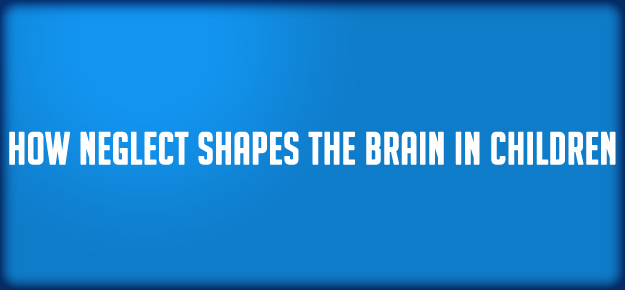scienceline | By Jillian Rose Lim | Posted June 25, 2014
Posted in: Featured, Health
Scientific evidence to support early intervention for neglected children continues to strengthen

A child’s early social environment can affect how its brain adapts to future stress. [Image credit: Paul Goyette ]
“What we found that day was very traumatic,” Fox tells me. “No matter how much we turned up the amplifiers on our equipment, the signal that was coming out of the brains of the kids in institutions were very small compared to typically developing children of the same age living in the community.”
The cause was not physical abuse in any conventional form. It wasn’t cuts, bruises or a blow to the head. Rather, it was the absence of consistent stimulation and response, kindness and warmth. In short, the cause was neglect.
A recent working paper by the Harvard Center on the Developing Child shows that Fox’s findings were just the start of a solid body of evidence for how neglect shapes a child’s developing brain. “Neglect” is defined as a caregiver’s lack of attention to a child’s physical, social and emotional needs. “The newest idea is that neglect has this lasting and permanent impact on the brain,” says Phil Fisher, a University of Oregon neuroscientist who studies American foster care. Fisher says science is becoming increasingly precise about what parts of the brain neglect can affect — the two main areas being, cortisol production and physical changes to the prefrontal cortex (the area of the brain that influences cognitive decision-making).
Neglect’s behavioral impact ranges from delayed language learning to poor problem solving to dysfunctional social behavior. But to understand how the experience of neglect — which is more like a permanent cavity than a bruise — can shape the brain, the story starts with the formation of neural patterns in infants.
Wiring the brain for a life of response
A baby’s brain begins to create connections between brain cells during its first year of life. When a baby repeatedly uses these connections — called synapses — they repeatedly strengthen the circuit, laying down grooves like those of a well-worn train track. According to neuroscientist Judy Cameron, at the University of Pittsburgh, if a child doesn’t use these circuits repeatedly the connections are likely to get pruned and wither away.
“Failing to encourage children to do specific things like talk, reason, read or think through problems will affect the development of brain circuits underlying those areas,” Cameron explains. “And if a child is neglected and they don’t have caring adults encouraging them to do these things, they won’t use those circuits over and over.”
Children must strengthen the reasoning, reading and learning circuits during particularly sensitive periods of brain development when pruning occurs heavily. Studies show these critical windows of time differ for the areas of brain development: for vision, visual stimulation is especially crucial from infancy to five years; for problem-solving, cognitive stimulation (like games and reading) is important until 12. And for social behavior, the Bucharest Early Intervention Project found that a warm social environment is especially important from infancy to two years. The BEIP found that children taken out of institutions and placed in good foster care before two years formed healthy attachments and good social development compared to those who stayed in an orphanage longer.
For neurobiologist Megan Gunnar, wiring the infant brain for close social interaction is crucial for thriving in society. At the University of Minnesota, Gunnar studies the biological importance of relationships. “We have evolved for our brains to develop in the context of relationships,” says Gunnar, explaining that it’s written in our biology to expect responsive interactions from a caregiver as infants. Gunnar calls this back-and-forth, ‘serve-and-return’ interaction “grips” for the baby’s brain to hold onto. When a baby reaches out to an adult, its brain organizes the adult’s response and reads the response as a signal — it is much like a returned throw in a game of catch.
“All the nerves, pathways made in producing that response were confirmed,” says Gunnar. “They were successful. Successful patterns of action repeated over and over bring food to those parts of the brain that help create the brain. You’re building the brain and that happens in the context of relationships.” As a child gets older, says Gunnar, such patterns allow the brain to better handle life’s stresses.
How do researchers try to measure neglect?
According to Phil Fisher, the strongest evidence for the impact of neglect comes from measuring electrical signals in the brain and cortisol production.
When Nathan Fox measured the Bucharest children’s brain signals, he attached sensors to their scalps and amplified the signals to observe them clearly. “It’s as if the brain’s dimmer switch had been turned down, and the amount of energy coming out of the children’s brain was extraordinarily small,” Fox says of the institutionalized children. A 2012 study led by Margaret Sheridan at the Boston Children’s Hospital found this was because the neglected children’s brains were not developing enough white matter, or myelin tract.
White matter covers and connects neurons and their axons. The substance speeds up the electrical signals between neurons, strengthening communication in the brain. An MRI conducted on the Bucharest children at eight years old revealed significantly less white matter development in institutionalized children compared to those in foster care. “That has significant consequences in terms of their ability to solve complex cognitive problems, as well as their executive functions,” says Fox.
But research shows neglect also impacts cortisol levels in the body. At the University of Delaware’s Infant Caregiver Lab, Mary Dozier found that neglected children produced less cortisol throughout the day as measured by saliva samples compared to children living in loving foster homes.
“Cortisol is a hormone of energy—it’s made by the body to give the body energy so if you’re stressed, you make energy to deal with the stress,” Nathan Fox explains. A typically developing child will produce high levels of cortisol in the morning that tapers off throughout the day. But neglected children show low levels in the morning and a flat rate throughout the day—an abnormal pattern of production that puts children at risk of not being able to activate stress responses in the body during stressful situations. “We looked to see whether we could change the flatter slope of cortisol for kids living under high-risk conditions,” says Dozier. “And we found after an early intervention, children show a steeper slope and a higher morning value.”
Early interventions like Dozier’s are designed to mediate the impact of neglect for children in high-risk environments while the children are still young. Dozier developed the Attachment and Biobehavioral Catch-Up (ABC) Intervention , a ten session parenting program carried out in the homes of neglectful parents. It aims to help parents become less frightening and more nurturing for their children. Dozier currently implements the intervention throughout the country, reaching about 300 foster children, and 200 children adopted internationally.
Is it ever too late?
As for the Bucharest Early Intervention Project, Fox says there is a good ending to the story. “We followed the children who were taken out of institutions, and their brain activity got larger and larger, until about eight, when we found they were now indistinguishable from community children in terms of their EEG signals,” says Fox. “They looked just like normal, healthy, happy kids.” Yet Fox and other researchers emphasize that despite this turnaround, timing matters.
“It’s never too late to help neglected children, but it will require tremendous effort and energy,” neuroscientist Charles Nelson — and Fox’s colleague in the BEIP — says. “Would I say, based on my work in Romania, people shouldn’t adopt a ten-year old? My answer is no. But just be prepared that child will have a range of developmental problems, and it will require a lot of resources. That child may never look like a perfectly normal child. But you will improve that child’s life.”
[ssba]

